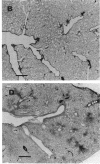Abstract
We investigated the in vitro and in vivo activities of macrolides against Mycoplasma pneumoniae. In vitro MICs of azithromycin, erythromycin, clarithromycin, and roxithromycin were determined. Azithromycin was the most potent antimicrobial agent tested in vitro. Its MIC for 90% of the strains was 0.00024 micrograms/ml. MICs for 90% of the strains of erythromycin, clarithromycin, and roxithromycin were 0.0156, 0.0078, and 0.03125 micrograms/ml, respectively. In vivo activities were assessed in a pulmonary infection model with Syrian golden hamsters. We evaluated the in vivo effects on reduction of viable M. pneumoniae cell counts and on reduction of microscopic and macroscopic histopathologies for azithromycin, erythromycin, and clarithromycin given at 10 mg/kg once daily for 1 and 3 days and given at 15 mg/kg twice daily for 2.5 and 5 days. Azithromycin was significantly more effective than erythromycin or clarithromycin in the same regimens. Especially at 10 mg/kg once daily for 1 day, only azithromycin was significantly effective in the reduction of viable M. pneumoniae cells and histopathologies. These results show that azithromycin is more efficacious than the other drugs tested against M. pneumoniae pneumonia in hamsters. These data suggest that clinical studies of macrolides in human patients are warranted.
Full text
PDF
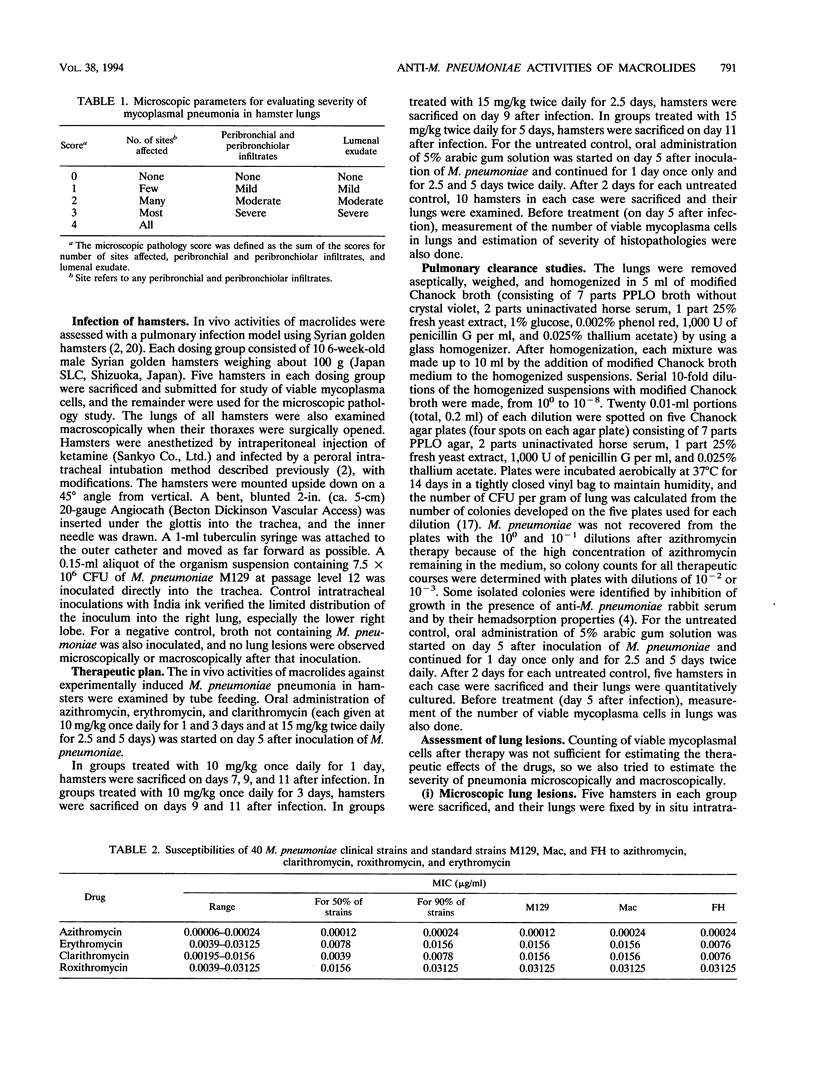
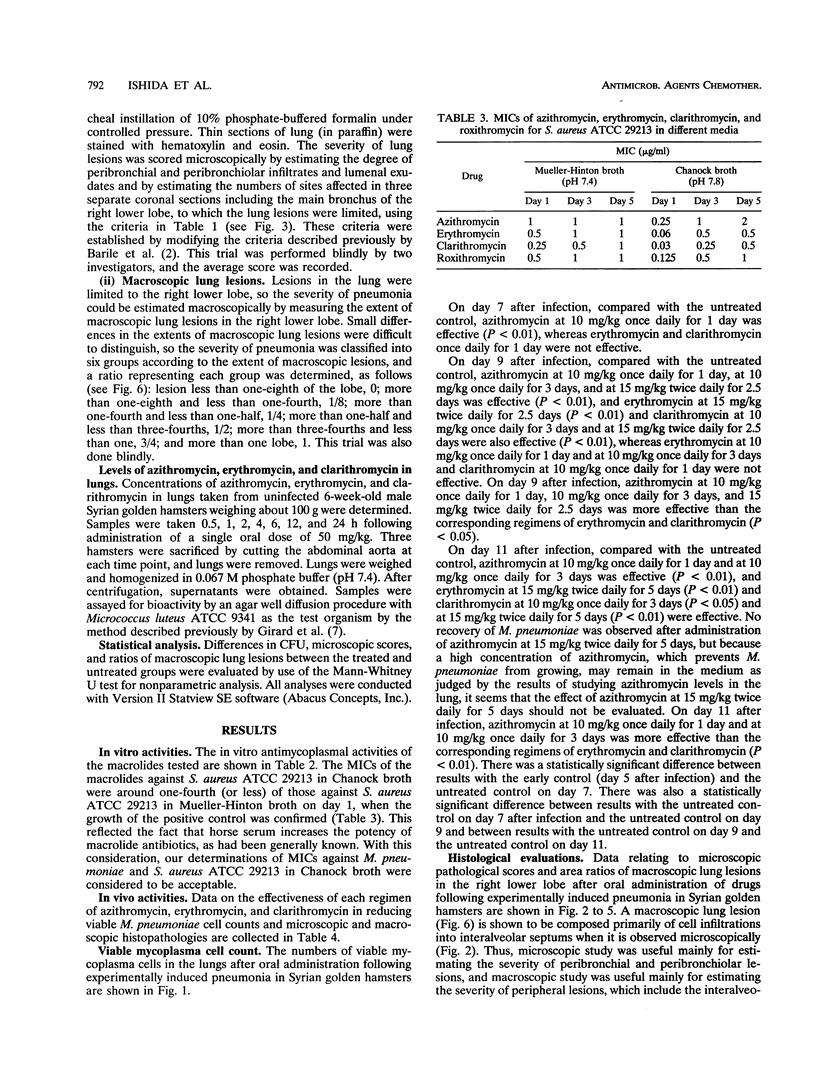



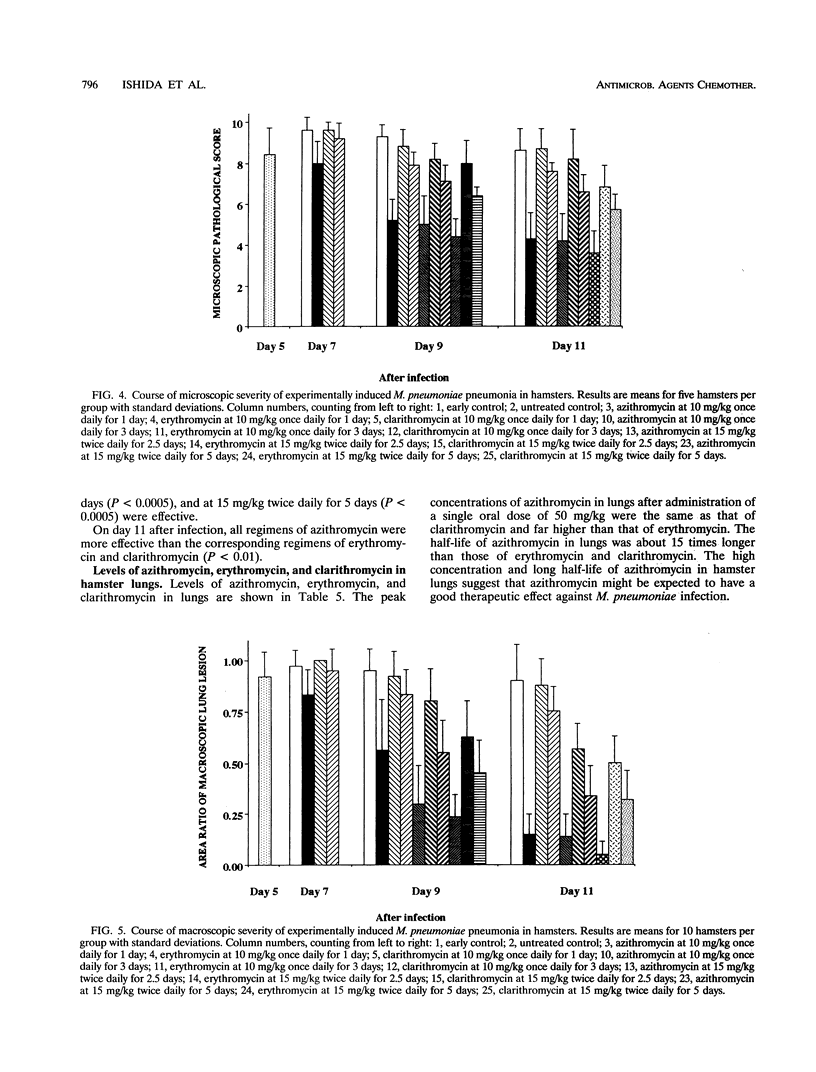
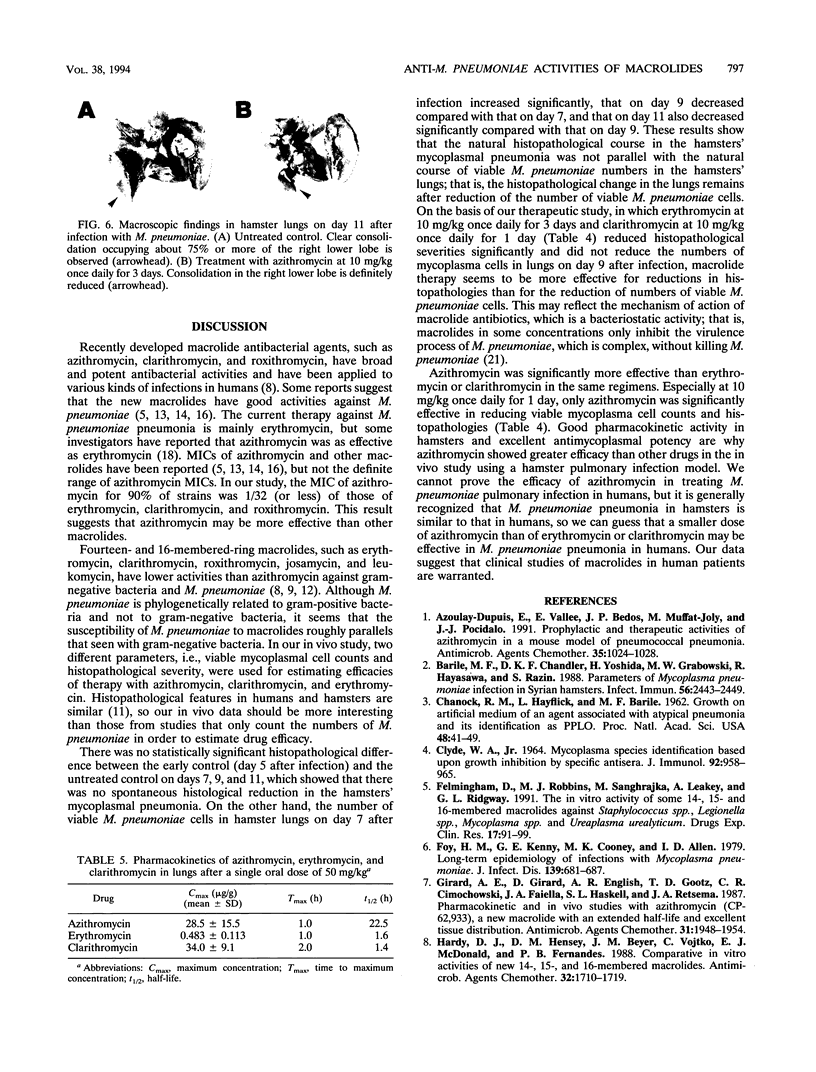

Images in this article
Selected References
These references are in PubMed. This may not be the complete list of references from this article.
- Azoulay-Dupuis E., Vallée E., Bedos J. P., Muffat-Joly M., Pocidalo J. J. Prophylactic and therapeutic activities of azithromycin in a mouse model of pneumococcal pneumonia. Antimicrob Agents Chemother. 1991 Jun;35(6):1024–1028. doi: 10.1128/aac.35.6.1024. [DOI] [PMC free article] [PubMed] [Google Scholar]
- Barile M. F., Chandler D. K., Yoshida H., Grabowski M. W., Harasawa R., Razin S. Parameters of Mycoplasma pneumoniae infection in Syrian hamsters. Infect Immun. 1988 Sep;56(9):2443–2449. doi: 10.1128/iai.56.9.2443-2449.1988. [DOI] [PMC free article] [PubMed] [Google Scholar]
- CHANOCK R. M., HAYFLICK L., BARILE M. F. Growth on artificial medium of an agent associated with atypical pneumonia and its identification as a PPLO. Proc Natl Acad Sci U S A. 1962 Jan 15;48:41–49. doi: 10.1073/pnas.48.1.41. [DOI] [PMC free article] [PubMed] [Google Scholar]
- CLYDE W. A., Jr MYCOPLASMA SPECIES IDENTIFICATION BASED UPON GROWTH INHIBITION BY SPECIFIC ANTISERA. J Immunol. 1964 Jun;92:958–965. [PubMed] [Google Scholar]
- Felmingham D., Robbins M. J., Sanghrajka M., Leakey A., Ridgway G. L. The in vitro activity of some 14-, 15- and 16- membered macrolides against Staphylococcus spp., Legionella spp., Mycoplasma spp. and Ureaplasma urealyticum. Drugs Exp Clin Res. 1991;17(2):91–99. [PubMed] [Google Scholar]
- Foy H. M., Kenny G. E., Cooney M. K., Allan I. D. Long-term epidemiology of infections with Mycoplasma pneumoniae. J Infect Dis. 1979 Jun;139(6):681–687. doi: 10.1093/infdis/139.6.681. [DOI] [PubMed] [Google Scholar]
- Girard A. E., Girard D., English A. R., Gootz T. D., Cimochowski C. R., Faiella J. A., Haskell S. L., Retsema J. A. Pharmacokinetic and in vivo studies with azithromycin (CP-62,993), a new macrolide with an extended half-life and excellent tissue distribution. Antimicrob Agents Chemother. 1987 Dec;31(12):1948–1954. doi: 10.1128/aac.31.12.1948. [DOI] [PMC free article] [PubMed] [Google Scholar]
- Hardy D. J., Hensey D. M., Beyer J. M., Vojtko C., McDonald E. J., Fernandes P. B. Comparative in vitro activities of new 14-, 15-, and 16-membered macrolides. Antimicrob Agents Chemother. 1988 Nov;32(11):1710–1719. doi: 10.1128/aac.32.11.1710. [DOI] [PMC free article] [PubMed] [Google Scholar]
- Kenny G. E., Cartwright F. D. Susceptibility of Mycoplasma pneumoniae to several new quinolones, tetracycline, and erythromycin. Antimicrob Agents Chemother. 1991 Mar;35(3):587–589. doi: 10.1128/aac.35.3.587. [DOI] [PMC free article] [PubMed] [Google Scholar]
- Kirst H. A., Sides G. D. New directions for macrolide antibiotics: pharmacokinetics and clinical efficacy. Antimicrob Agents Chemother. 1989 Sep;33(9):1419–1422. doi: 10.1128/aac.33.9.1419. [DOI] [PMC free article] [PubMed] [Google Scholar]
- Osada Y., Ogawa H. Antimycoplasmal activity of ofloxacin (DL-8280). Antimicrob Agents Chemother. 1983 Mar;23(3):509–511. doi: 10.1128/aac.23.3.509. [DOI] [PMC free article] [PubMed] [Google Scholar]
- Renaudin H., Bébéar C. Comparative in vitro activity of azithromycin, clarithromycin, erythromycin and lomefloxacin against Mycoplasma pneumoniae, Mycoplasma hominis and Ureaplasma urealyticum. Eur J Clin Microbiol Infect Dis. 1990 Nov;9(11):838–841. doi: 10.1007/BF01967388. [DOI] [PubMed] [Google Scholar]
- Renaudin H., Tully J. G., Bebear C. In vitro susceptibilities of Mycoplasma genitalium to antibiotics. Antimicrob Agents Chemother. 1992 Apr;36(4):870–872. doi: 10.1128/aac.36.4.870. [DOI] [PMC free article] [PubMed] [Google Scholar]
- Retsema J., Girard A., Schelkly W., Manousos M., Anderson M., Bright G., Borovoy R., Brennan L., Mason R. Spectrum and mode of action of azithromycin (CP-62,993), a new 15-membered-ring macrolide with improved potency against gram-negative organisms. Antimicrob Agents Chemother. 1987 Dec;31(12):1939–1947. doi: 10.1128/aac.31.12.1939. [DOI] [PMC free article] [PubMed] [Google Scholar]
- Rylander M., Hallander H. O. In vitro comparison of the activity of doxycycline, tetracycline, erythromycin and a new macrolide, CP 62993, against Mycoplasma pneumoniae, Mycoplasma hominis and Ureaplasma urealyticum. Scand J Infect Dis Suppl. 1988;53:12–17. [PubMed] [Google Scholar]
- Sasaki Y., Ogura A., Nakayama K., Noguchi Y., Matsuno K., Saito M. Susceptibility of newly established mouse strain MPS to Mycoplasma pneumoniae infection. Microbiol Immunol. 1991;35(3):247–252. doi: 10.1111/j.1348-0421.1991.tb01553.x. [DOI] [PubMed] [Google Scholar]
- Schönwald S., Gunjaca M., Kolacny-Babić L., Car V., Gosev M. Comparison of azithromycin and erythromycin in the treatment of atypical pneumonias. J Antimicrob Chemother. 1990 Jan;25 (Suppl A):123–126. doi: 10.1093/jac/25.suppl_a.123. [DOI] [PubMed] [Google Scholar]
- Shames J. M., George R. B., Holliday W. B., Rasch J. R., Mogabgab W. J. Comparison of antibiotics in the treatment of mycoplasmal pneumonia. Arch Intern Med. 1970 Apr;125(4):680–684. [PubMed] [Google Scholar]
- Slotkin R. I., Clyde W. A., Jr, Denny F. W. The effect of antibiotics on Mycoplasma pneumoniae in vitro and in vivo. Am J Epidemiol. 1967 Jul;86(1):225–237. doi: 10.1093/oxfordjournals.aje.a120727. [DOI] [PubMed] [Google Scholar]
- Waites K. B., Cassell G. H., Canupp K. C., Fernandes P. B. In vitro susceptibilities of mycoplasmas and ureaplasmas to new macrolides and aryl-fluoroquinolones. Antimicrob Agents Chemother. 1988 Oct;32(10):1500–1502. doi: 10.1128/aac.32.10.1500. [DOI] [PMC free article] [PubMed] [Google Scholar]
- Waites K. B., Duffy L. B., Schmid T., Crabb D., Pate M. S., Cassell G. H. In vitro susceptibilities of Mycoplasma pneumoniae, Mycoplasma hominis, and Ureaplasma urealyticum to sparfloxacin and PD 127391. Antimicrob Agents Chemother. 1991 Jun;35(6):1181–1185. doi: 10.1128/aac.35.6.1181. [DOI] [PMC free article] [PubMed] [Google Scholar]




